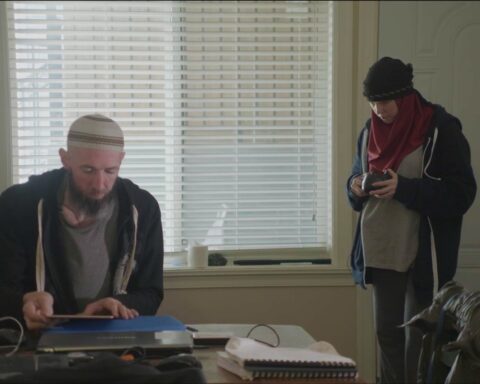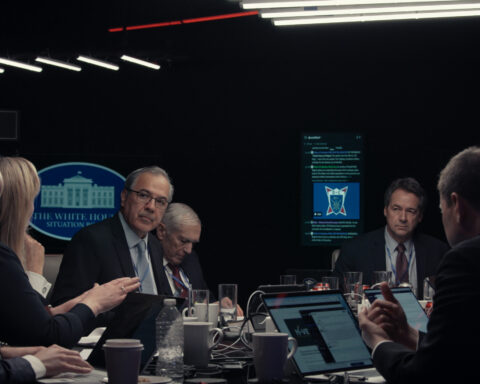John Lewis: Good Trouble
(USA, 97 min.)
Dir. Dawn Porter
“I feel luck and blessed that I am serving in our country,” says Congressman John Lewis in Good Trouble. “But there are forces today that are trying to take us back to another time and darken progress. We’ve come so far and made so much progress, but as a nation, we’re not there yet.”
Congressional representative and civil rights leader John Lewis receives a timely profile in John Lewis: Good Trouble. This upbeat portrait from Dawn Porter (Bobby Kennedy for President) unpacks the significant life and career of the Representative from Georgia. Good Trouble witnesses the hard fought battle for voting rights in America through Lewis’s eyes. He recalls the punches he took and the ground on which he stood to ensure that Black Americans had equal say in the democracy of their nation. However, as the energetic 80-year-old Lewis reflects upon his career, he doesn’t take for granted the challenges in the present.
One moment in the film observes Lewis as he describes a plaque on his wall. It depicts a pair of hands picking cotton above a hand casting a ballot. This collection of hands symbolises Lewis’s life, career, and legacy. As a child, he picked cotton on the family farm in rural Alabama, a descendant of slaves and sharecroppers who could not have a say in the laws that governed their lives. Now, those same hands not only cast a ballot, they help write the law. In this one life, the film explores the ongoing fight for liberty in America.
Porter’s film goes beyond the hagiographical portraiture that often befalls a profile of a figure as worthy of esteem as Lewis. She, like Lewis, recognizes that the fight for voting rights is as important now as it was when Lewis marched alongside Dr. Martin Luther King, Jr. and other activists on the Edmund Pettus Bridge in 1965. Good Trouble weaves a mostly chronological account of Lewis’s career with an assessment of the present concerns for voter suppression in the USA. Using the controversial 2013 ruling that rolled back precautions of the Voting Rights Act for which Lewis and others fought, Porter’s portrait of Lewis speaks directly to the ongoing pervasiveness of systemic racism in America as the battle for equal rights mutates and the forces of white supremacy come out of hiding. The film is an invigorating call to action for audiences to join Lewis in his fight and head to the polls no matter the costs.
At the heart of the film’s battle cry is Lewis’s belief in “good trouble.” He distinguishes “good trouble” from “bad trouble” by noting the difference between delinquent behaviour and civil disobedience. Good trouble, Lewis explains, means standing one’s ground and defying one’s oppressor through non-violent resistance. He prides himself on over 40 arrests during his career and expects more to come.
Porter creates a living document of Lewis’s history with good trouble as she projects archival footage of his civil rights activism before his eyes. Lewis watches black-and-white images of protests, marches, and sit-ins. He sees images of himself bandaged and bloodied. Lewis remarks that he is seeing some of the footage for the first time, including the extraordinary documentation of the lunch counter sit-ins during which he and other activists occupied the stools of cafés and diners to demonstrate that Black Americans deserved their seat at the table just as much as anybody else did.
This footage depicts Lewis and others sitting stoically while white ruffians respond by dumping milkshakes on them, abusing them physically, and hurling vile insults. Even as other interviewees in the film admit that they could never have withstood the torment that Lewis endured, his reluctance to respond to violence with force is admirable. His actions are the essence of Michelle Obama’s message, “When they go low, we go high” decades later. As protests for Black rights continue to erupt today, the images speak to the importance of taking to the streets and standing one’s ground to inspire change.
The doc features a number of Lewis’s colleagues in US Congress who reflect his youthful entry in politics. Interviewees like Alexandria Ocasio-Cortez, Ilhan Omar, and Rashida Tlaib are catalysts for change who join him in his fight. Good Trouble enjoys impressive access to figures of contemporary American politics like Hillary Clinton, Nancy Pelosi, and Stacey Abrams. They all praise Lewis, but also echo his sentiment that the fight continues. Good Trouble ends by reminding audiences that Lewis’s legacy is not simply his civil rights activism, but also his career as a legislator. The doc offers a roll call of Lewis’s contributions to America’s democracy while culminating with his fierce efforts to protect health care for all Americans and to hold Donald Trump accountable by disclosing his tax returns, among other fights.
Past and present combine as Porter’s cameras join Lewis on his annual pilgrimage to the Edmund Pettus Bridge. The archival footage and the contemporary images might carry markers of age, but the steps Lewis takes remain as urgent now as they were then. Good Trouble is an invigorating call to join the march as the “good trouble” that Lewis preaches is to respond to voter suppression with voter mobilization. One hopes it inspires Americans to do all they can and get out the vote.
John Lewis: Good Trouble opens July 3 at the Globe Cinema in Calgary (wear a mask!) and on home video.











